
Machimosaurus is an extinct genus of machimosaurid crocodyliform from the Late Jurassic and Early Cretaceous. The type species, Machimosaurus hugii, was found in Switzerland. Other fossils have been found in England, France, Germany, Portugal, Switzerland and Tunisia. Machimosaurus rex is the largest named teleosauroid and thalattosuchian, with an estimated length of up to 7.15 m (23.5 ft). Machimosaurus is the largest known crocodyliform of the Jurassic.

Metriorhynchus is an extinct genus of marine crocodyliform that lived in the oceans during the Late Jurassic. The type species, M. brevirostris was named in 1829 as a species of Steneosaurus before being named as a separate genus by the German palaeontologist Christian von Meyer in 1832. The name Metriorhynchus means "Moderate snout", and is derived from the Greek Metrio- ("moderate") and -rhynchos ("snout").

Thalattosuchia is a clade of mostly marine crocodylomorphs from the Early Jurassic to the Early Cretaceous that had a cosmopolitan distribution. They are colloquially referred to as marine crocodiles or sea crocodiles, though they are not members of Crocodilia and records from Thailand and China suggest that some members lived in freshwater. The clade contains two major subgroupings, the Teleosauroidea and Metriorhynchoidea. Teleosauroids are not greatly specialised for oceanic life, with back osteoderms similar to other crocodyliformes. Within Metriorhynchoidea, the Metriorhynchidae displayed extreme adaptions for life in the open ocean, including the transformation of limbs into flippers, the development of a tail fluke, and smooth, scaleless skin, and probably gave live birth, seemingly uniquely among archosaurs.
Teleosaurus is an extinct genus of teleosaurid crocodyliform found in the Middle Jurassic Calcaire de Caen Formation of France. It was approximately 3 metres (10 ft) in length. The holotype is MNHN AC 8746, a quarter of a skull and other associated postcranial remains, while other fragmentary specimens are known. The type species is T. cadomensis, but a second species, T. geoffroyi may also exist. It was previously considered a wastebasket taxon, with many other remains assigned to the genus.

Steneosaurus is a dubious genus of teleosaurid crocodyliform from the Middle or Late Jurassic of France. The genus has been used as a wastebasket taxon for thalattosuchian fossils for over two centuries, and almost all known historical species of teleosauroid have been included within it at one point. The genus has remained a wastebasket, with numerous species still included under the label ‘Steneosaurus’, many of which are unrelated to each other.

Aeolodon is an extinct genus of teleosaurid crocodyliform reptile from the Late Jurassic (Tithonian) of Germany and France that was initially named as a species of Crocodylus in 1814. Although previously synonymized with Steneosaurus, recent cladistic analysis considers it distantly related to the Steneosaurus type species and the type species is A. priscus, named in 1830 and described in 2020.
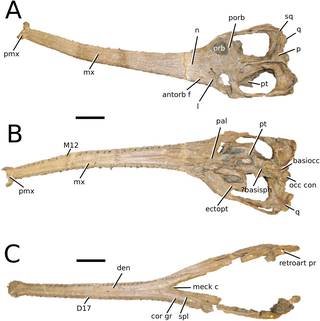
Mycterosuchus is an extinct genus of teleosaurid crocodyliform from the Middle Jurassic (Callovian) of England. Although previously synonymized with Steneosaurus, recent cladistic analysis considers it distantly related to the Steneosaurus type species.

Sericodon is an extinct genus of teleosaurid crocodyliform from the Late Jurassic (Tithonian) of Germany and Switzerland. The genus contains a single species, S. jugleri. Sericodon was placed in 'Clade T' (Aeolodontinae) and was found to be the sister taxon to Bathysuchus, another teleosaurid.

Macrospondylus is an extinct genus of machimosaurid teleosauroid crocodyliform from the Early Jurassic (Toarcian) of Europe. Fossils are known from the Posidonia Shale of Germany, the Whitby Mudstone of the United Kingdom, and the "schistes bitumineux" of Luxembourg.

Bathysuchus is an extinct genus of teleosaurid thalattosuchian from Late Jurassic (Kimmeridgian) deep water marine deposits in England and France. Bathysuchus displays features that suggest it was more pelagic than other teleosaurids, including smoother skull bones and reduced armour plating, similar to the fully marine metriorhynchids. This was possibly an adaptation to rising sea levels during the Kimmeridgian, as its earlier relatives such as Teleosaurus were suited for shallow coasts and lagoon environments.

Lemmysuchus is a genus of machimosaurid thalattosuchian from the Middle Jurassic Callovian of England and France. Like many other teleosauroids from Europe, it has had a convoluted taxonomic history.
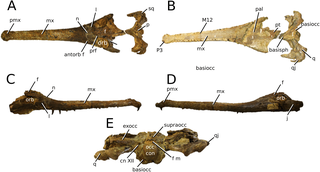
Deslongchampsina is an extinct genus of machimosaurid crocodyliform from the Middle Jurassic (Bathonian) Cornbrash Formation of England and France, possibly from the Calcaire de Caen. The type and only known species is D. larteti, which was variously referred to Teleosaurus and the wastebasket taxon Steneosaurus before its distinction was formally recognised in 2019. Its snout was not as elongated as some other teleosauroids (mesorostrine), and the shape of its jaws and teeth suggest that it was a generalist predator, unlike the more powerful contemporary machimosaurin Yvridiosuchus.
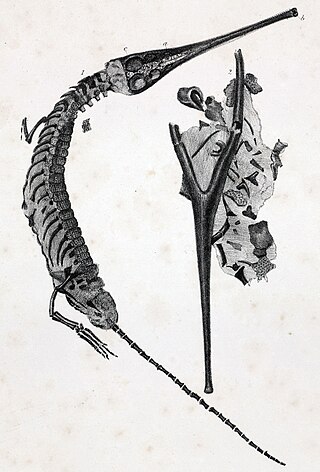
Teleosauroidea is an extinct superfamily of thalattosuchian crocodyliforms living from the Early Jurassic to the Early Cretaceous.

Plagiophthalmosuchus is a genus of teleosauroid, known form the Early Jurassic Whitby Mudstone Formation of Whitby, Yorkshire, UK, and Dudelange, Luxembourg. The type species, P. gracilirostris, was originally named as a species of Teleosaurus in 1836, but then it was moved to Steneosaurus in 1961, but it was again moved to its own genus in 2020.
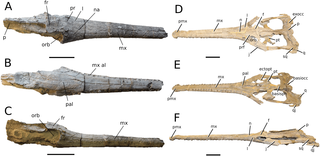
Neosteneosaurus is a genus of machimosaurid, known from the Middle Jurassic Oxford Clay of the UK, and Marnes de Dives, France. The type species, N. edwardsi, was originally named as a species of Steneosaurus in 1868, but was moved to its own genus in 2020. Steneosaurus durobrivensis and Steneosaurus hulkei are considered junior synonyms.

Machimosauridae is an extinct family of teleosauroid thalattosuchian crocodyliforms. The family was first identified in 2016, when fossils of teleosauroid thalattosuchians, including an indeterminate close relative of Lemmysuchus and Machimosaurus, were described from the Middle Jurassic (Bathonian) of Morocco. The family was largely expanded in 2020 when the systematics of Teleosauroidea were re-reviewed. Members of this family generally were larger than the teleosaurids.

Andrianavoay is an extinct genus of teleosauroid from the Bathonian Kandreho Formation of Madagascar.

Clovesuurdameredeor is an extinct genus of machimosaurid teleosauroid from the Bathonian Cornbrash Formation of England.

Proexochokefalos is an extinct genus of machimosaurid teleosauroid from the Jurassic of France
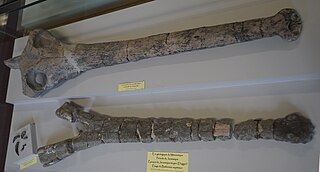
Seldsienean in an extinct genus of machimosaurid thalattosuchian from the Middle Jurassic of England and France. It is known from the Calcaire de Caen and the Cornbrash Formation.





















